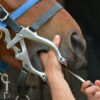Learn Vital horse strangles management, covering diagnosis, prevention, and care to maintain your equine friend’s health and well-being.
Strangles management in horses is crucial to maintaining equine health and preventing the spread of this highly contagious disease.
As horse owners, stable managers, and professionals within the equine industry, it’s essential to understand the causes, symptoms, diagnosis methods, and treatment options for strangles.
This comprehensive blog post on Strangles Management in Horses will delve into various aspects of managing strangles infections among our beloved equines.
We’ll discuss effective isolation procedures to prevent further contamination and the precautions to take when introducing new arrivals.
If you’re worried about Strangles, Speak to Clarendon Equine today for more advice on this subject and all your equine veterinary needs.
Table of Contents:
- Understanding Strangles in Horses
- Diagnosing Strangles
- Treating and Managing Infected Horses
- Implementing Isolation Procedures at Yards
- Preventing Water Contamination
- Precautions for New Arrivals at Yards
- Conclusion
Understanding Strangles in Horses
Strangles is a bacterial infection that affects the upper respiratory tract of horses, caused by Streptococcus equi.
Symptoms of strangles in horses include fever, a runny nose and enlarged lymph nodes which could form abscesses.
It is one of the most common and highly contagious diseases in the equine industry, affecting the health of infected horses and potentially spreading to others.
One of the biggest challenges in controlling equine strangles is the presence of carrier horses that show no clinical signs but can still transmit the bacteria to others.
Younger horses are more susceptible to infection, and outbreaks are more common in facilities with high horse density and frequent horse movement.
- Causes of strangles in horses: The bacteria responsible for this disease are transmitted through direct contact between infected animals and healthy animals or indirectly via shared equipment, water sources, or even human handlers. Eradication strategies such as isolation, testing, and vaccination of susceptible horses can help prevent outbreaks.
- Symptoms and severity: While some affected horses may only exhibit mild signs like coughing or nasal discharge, others could experience life-threatening complications due to abscess formation near vital structures such as the guttural pouches. Vaccinated horses may have milder symptoms and a shorter duration of illness.
Strangles is a contagious and severe ailment in horses. By adequately diagnosing strangles, horse owners can take steps to protect their animals from further infection or complications. Early detection and disease control measures can help prevent the spread of the disease and minimise its impact on horse health and welfare.
Protect your horses from the highly contagious and potentially life-threatening bacterial infection, strangles. Learn about its causes, symptoms, and management to keep your equine friends healthy. #StranglesInHorses #EquineHealthClick to Tweet
Diagnosing Strangles
Diagnosis involves identifying the bacteria’s DNA through various methods like swabbing the horse’s throat or washing their guttural pouches. Blood tests are also helpful for detecting carriers among seemingly healthy animals.
Swabbing Techniques for Diagnosis
Swabbing techniques like nasopharyngeal and guttural pouch swabs help collect samples from horses infected with strangles. These methods ensure accurate results while minimising discomfort to the animal.
Guttural Pouch Wash Method
The guttural pouch wash technique involves flushing saline into the horse’s guttural pouches and retrieving a sample. This process helps identify any presence of Streptococcus equi bacteria, confirming an equine strangles infection.
Importance of Blood Testing
- Blood tests can detect carrier horses that may not show symptoms but can still spread the disease.
- A series of negative blood tests confirm successful eradication and allow affected horses to return safely to normal activities.
Accurate diagnosis of strangles is paramount in managing and treating infected horses. We can ensure that our equine companions fully recover from this infection with proper care, temperature monitoring, and abscess treatments.
“Early detection is key in managing equine strangles infections. Swabbing and blood tests can help diagnose carriers and ensure successful eradication.” #horsehealth #stranglesmanagementClick to Tweet
Treating and Managing Infected Horses
Once diagnosed, provide proper care to ensure recovery. This includes treating open abscesses cautiously while monitoring temperature twice daily. A negative guttural pouch wash followed by two consecutive negative blood tests (two weeks apart) confirms an absence of infection.
Caring for Open Abscesses
Horses with open abscesses require attentive nursing, including regular cleaning and disinfection of the affected area. It’s crucial to wear gloves and follow strict hygiene protocols when handling infected horses to prevent bacteria from spreading.
Monitoring Temperature Regularly
All horses should have their temperature taken twice daily during a strangles outbreak, as fever is often one of the first signs of infection. Early detection allows for prompt treatment, reducing the risk of affecting equine health in younger horses.
Ensuring Full Recovery from Infection
For treating and managing infected horses, it is essential to provide the necessary care for open abscesses, monitor the temperature regularly and ensure a complete recovery from infection. Implementing isolation procedures with an appropriate classification system is paramount to prevent the further spread of strangles in a yard or stable environment.
“Proper care is crucial in managing equine strangles. Regular temperature monitoring and attentive nursing of open abscesses can aid in a horse’s recovery.” #horsehealth #stranglesmanagementClick to Tweet
Implementing Isolation Procedures at Yards
To prevent further spread within a yard or stable environment, isolation procedures must be implemented when dealing with infected horses. Divide them into “red” (infected) and “amber” (exposed but not yet showing signs) groups while ensuring owners only handle their own animals during this period.
It is important to remember that isolation procedures are the most effective way of controlling Strangles in horses, and proper implementation at yards can help ensure success.
Moving on, preventing water contamination should also be considered when managing Strangles outbreaks, as this bacteria can survive for long periods in water sources.
“Prevent the spread of equine strangles by implementing isolation procedures and involving owners in red vs amber classification system. #horsehealth #biosecurity “Click to Tweet
Preventing Water Contamination
The bacteria causing equine strangles can survive up to 30-40 days in water sources, making it crucial to effectively manage water waste disposal and change points. By paying attention to where contaminated water is discarded, you can ensure it does not come into contact with other horses or shared resources.
Proper Management of Water Sources
- Avoid dumping infected horses’ drinking water near common areas or other animals’ troughs.
- Clean and disinfect shared troughs regularly.
- Create designated areas for changing and disposing of potentially contaminated water away from healthy horses.
Preventing water contamination is essential to reduce the risk of strangles bacteria survival in horses. Therefore, it is vital to take precautions for new arrivals at yards and ensure proper management of water sources.
Precautions for New Arrivals at Yards
Taking proactive measures when introducing new horses is essential to maintain a strangles-free yard. By following these steps, you can prevent the introduction of carrier horses that may spread the infection among healthy animals already present on your property.
- Blood testing new arrivals: Before allowing entry, ensure all incoming horses are tested for equine strangles by conducting a blood test. This helps identify potential carriers and keep your yard safe from strangles infections.
- Three-week isolation period: Isolate new arrivals for three weeks as an added precaution. Monitor the health of new arrivals closely during their three-week isolation period and be watchful for any signs of infection.
Vaccinated horses are not immune to the disease but less likely to develop severe symptoms. Younger horses, especially those under five years old, are more susceptible to the disease due to their underdeveloped immune systems. Therefore, disease control is essential in preventing the spread of equine strangles.
By taking precautions when introducing new horses and monitoring the health of all animals on your property, you can help keep your yard strangles-free.
Conclusion
Strangles Management for Horses is a crucial topic for all horse owners, stable owners, and those in the equine industry.
Equine strangles infections are common among horses and can negatively affect their health if not managed properly.
By implementing safety measures and being vigilant about your horse’s health, you can ensure they remain healthy and free from equine strangles outbreaks.
Remember that eradicating equine strangles requires collective efforts from everyone in the equine industry.
For treatment, advice, or help, call Clarendon Equine today and get the best veterinary care for your equine friend.








